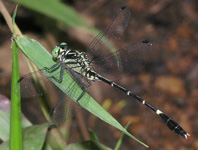Abstract
We describe a new species of treefrog from northern Australia. Litoria bella sp. nov. is morphologically and genetically most similar to frogs in the L. gracilenta and L. chloris groups but is distinguished from all members in these groups by a combination of a moderately large male body size (34.5–41.8 mm SVL), near-immaculate green dorsum, orange venter, bright orange digits and webbing, bluish purple lateral surfaces of the thighs, no pale canthal stripe, white bones, and a highly-pulsed, single-note, male advertisement call with a pulse rate of 56–64 pulses/s and dominant frequency of 2.6–2.8 kHz. Litoria bella sp. nov. has a patchy distribution across the Cape York Peninsula, inhabiting rainforest and monsoon vine thicket in close association with watercourses. The new species’ affinities lie with L. auae from southern New Guinea rather than with L. gracilenta from eastern Australia. Molecular data suggest that the L. gracilenta group should be expanded to include L. chloris and L. xanthomera, two moderately large green treefrogs from eastern Australia.
References
Arèvalo, E., Davis, S.K. & Sites, J.W. (1994) Mitochondrial DNA sequence divergence and phylogenetic relationships among eight chromosome races of the Sceloporus grammicus complex (Phrynosomatidae) in central Mexico. Systematic Biology, 43, 387–418.
http://dx.doi.org/10.1093/sysbio/43.3.387Alberch, P. & Gale, E.A. (1985) A developmental analysis of an evolutionary trend: digital reduction in amphibians. Evolution, 1985, 8–23.
http://dx.doi.org/10.2307/2408513Bowman, D.M., Brown, G.K., Braby, M.F., Brown, J.R., Cook, L.G., Crisp, M.D., Ford, F., Haberle, S., Hughes, J., Isagi, Y. & Joseph, L. (2010) Biogeography of the Australian monsoon tropics. Journal of Biogeography, 37, 201–216.
http://dx.doi.org/10.1111/j.1365-2699.2009.02210.xBurns, E.L. & Crayn, D.M. (2006) Phylogenetics and evolution of bell frogs (Litoria aurea species-group, Anura: Hylidae) based on mitochondrial ND4 sequences. Molecular Phylogenetics and Evolution, 39, 573–579.
http://dx.doi.org/10.1016/j.ympev.2005.11.017Cracraft, J. (1986) Origin and evolution of continental biotas: speciation and historical congruence within the Australian avifauna. Evolution, 40, 977–996.
http://dx.doi.org/10.2307/2408757Cogger, H. (2014) Reptiles and amphibians of Australia. CSIRO Publishing, 1033 pp.
Duellman, W.E., Marion, A.B. & Hedges, S.B. (2016) Phylogenetics, classification, and biogeography of the treefrogs (Amphibia: Anura: Arboranae). Zootaxa, 4104 (1), 1–109.
http://dx.doi.org/10.11646/zootaxa.4104.1.1Eldridge, M.D.B., Heckenberg, K., Neaves, L.E., Metcalfe, C.J., Hamilton, S., Johnson, P.M. & Close, R.L. (2011) Genetic differentiation and introgression amongst Thylogale (pademelons) taxa in eastern Australia. Australian Journal of Zoology, 59, 103–117.
http://dx.doi.org/10.1071/ZO11022Glaw, F. & Vences, M. (1997) Anuran eye colouration: definitions, variation, taxonomic implications and possible functions. Herpetologia Bonnensis. SEH Proceedings, Bonn, pp.125–138.
Günther, R. & Richards, S.J. (2000) A new species of the Litoria gracilenta group from Irian Jaya (Anura: Hylidae). Herpetozoa, 13, 27–43.
Horst, R. (1883) On new and little-known frogs from the Malayan archipelago. Notes from the Leyden Museum, 5, 235–244.
James, C.H. & Moritz, C. (2000) Intraspecific phylogeography in the sedge frog Litoria fallax (Hylidae) indicates pre-Pleistocene vicariance of an open forest species from eastern Australia. Molecular Ecology, 9, 349–358.
http://dx.doi.org/10.1046/j.1365-294x.2000.00885.xKraus, F. (2013) A new treefrog of the Litoria gracilenta group (Hylidae) from Papua New Guinea. Proceedings of the Biological Society of Washington, 126, 151–160.
http://dx.doi.org/10.2988/0006-324X-126.2.151Kraus, F. & Allison, A. (2009) New species of frogs from Papua New Guinea. Bishop Museum Occasional Papers, 104, 1–36.
Lavarack, P.S. & Godwin, M. (1987) Rainforests of northern Cape York Peninsula. In: Werren, G.L. & Kershaw, A.P. (Eds), The Rainforest Legacy, Vol. 1. Australian Heritage Publication Series Number 7 (1). Australian Government Publishing Service, Canberra, pp. 201–222.
Mahony, M., Knowles, R., Foster, R. & Donnellan, S. (2001) Systematics of the Litoria citropa (Anura: Hylidae) complex in northern New South Wales and southern Queensland, Australia, with the description of a new species. Records of the Australian Museum, 53, 37–48.
http://dx.doi.org/10.3853/j.0067-1975.53.2001.1322McGuigan, K., Zhu, D., Allen, G.R. & Moritz, C. (2000) Phylogenetic relationships and historical biogeography of melanotaeniid fishes in Australia and New Guinea. Marine and Freshwater Research, 51, 713–723.
http://dx.doi.org/10.1071/MF99159Menzies, J.I. (1976) Handbook of common New Guinea frogs. No. 1. Wau Ecology Institute, Wau, Papua New Guinea, 75 pp.
Menzies, J.I. & Tyler, M.J. (2004) Litoria gracilenta (Anura: Hylidae) and related species in New Guinea. Australian Journal of Zoology, 52, 191–214.
http://dx.doi.org/10.1071/ZO03008Menzies, J. (2006) The frogs of New Guinea and the Solomon Islands. Pensoft Publishers, 345 pp.
Oliver, P.M., Stuart-Fox, D. & Richards, S.J. (2008) A new species of treefrog (Hylidae, Litoria) from the southern lowlands of New Guinea. Current Herpetology, 27, 35–42.
http://dx.doi.org/10.3105/1345-5834(2008)27[35:ANSOTH]2.0.CO;2Palumbi, S. (1991) Simple fool's guide to PCR. Honolulu: University of Hawaii.
Peters, W.C.H. (1869) Über neue Saurier (Chaunolaemus multicarinatus, Tropidolepisma Richardi und Gymnodactylus steudneri) und Batrachier (Cyclorhamphus fasciatus und Hyla gracilenta). Monatsberichte der Königlichen Preussische Akademie des Wissenschaften zu Berlin, 1869, 786–790.
Richards, S.J. & Oliver, P. (2006) Two new species of large green canopy-dwelling frogs (Anura: Hylidae: Litoria) from Papua New Guinea. Zootaxa, 1295, 41–60.
Richards, S.J., Oliver, P., Krey, K. & Tjaturadi, B. (2009) A new species of Litoria (Amphibia: Anura: Hylidae) from the foothills of the Foja Mountains, Papua Province, Indonesia. Zootaxa, 2277, 1–13.
Sattler, P.S. & Williams, R.D. (1999) The Conservation Status of Queensland Bioregional Ecosystems. Environmental Protection Agency, Brisbane.
Smith, K.L., Hale, J.M., Kearney, M.R., Austin, J.J. & Melville, J. (2013) Molecular patterns of introgression in a classic hybrid zone between the Australian tree frogs, Litoria ewingii and L. paraewingi: evidence of a tension zone. Molecular Ecology, 22, 1869–1883.
http://dx.doi.org/10.1111/mec.12176Tyler, M.J. & Davies, M. (1978) Species-groups within the Australopapuan hulid frog genus Litoria Tschudi. Australian Journal of Zoology, 26, 1–47.
http://dx.doi.org/10.1071/AJZS063

